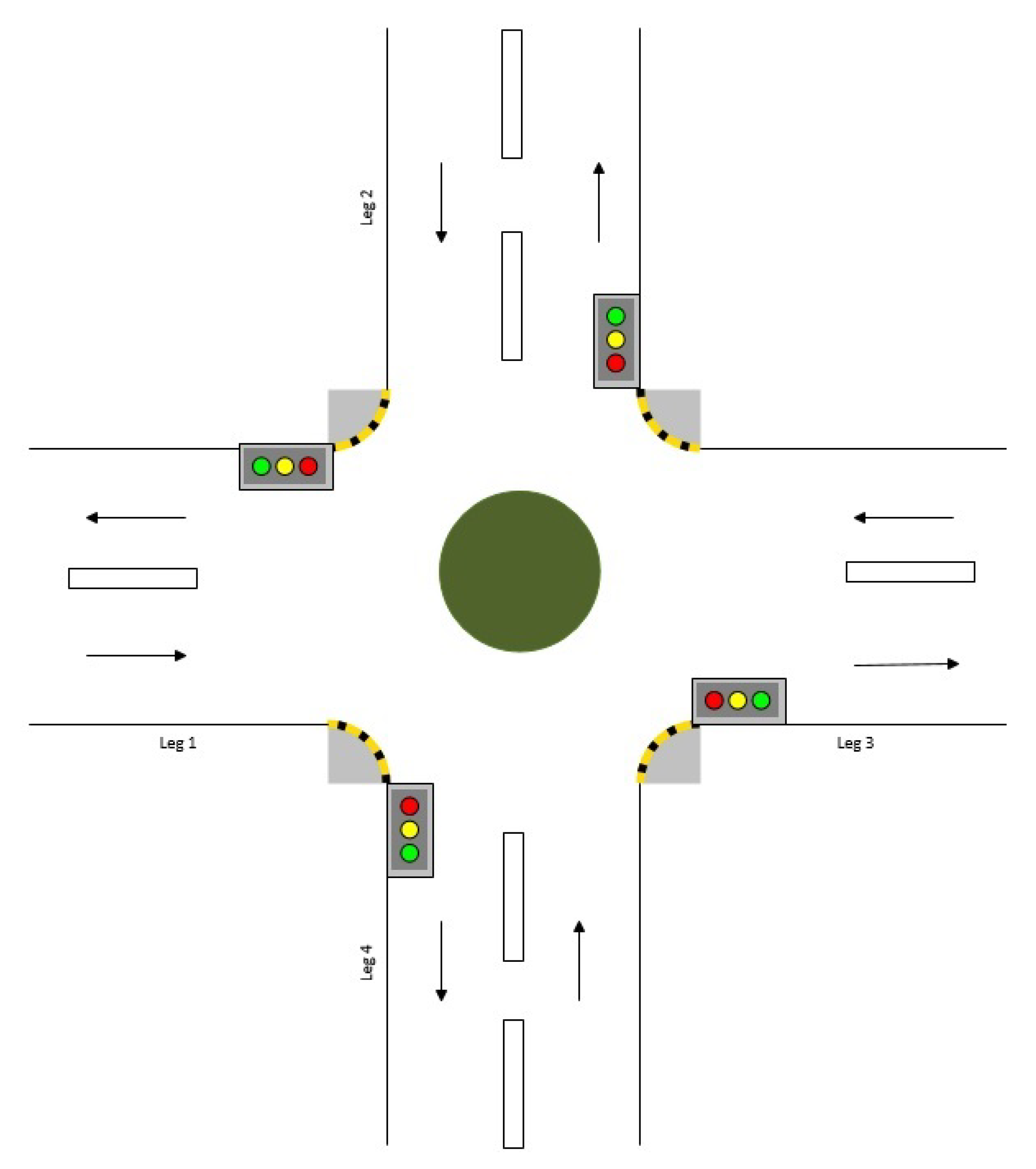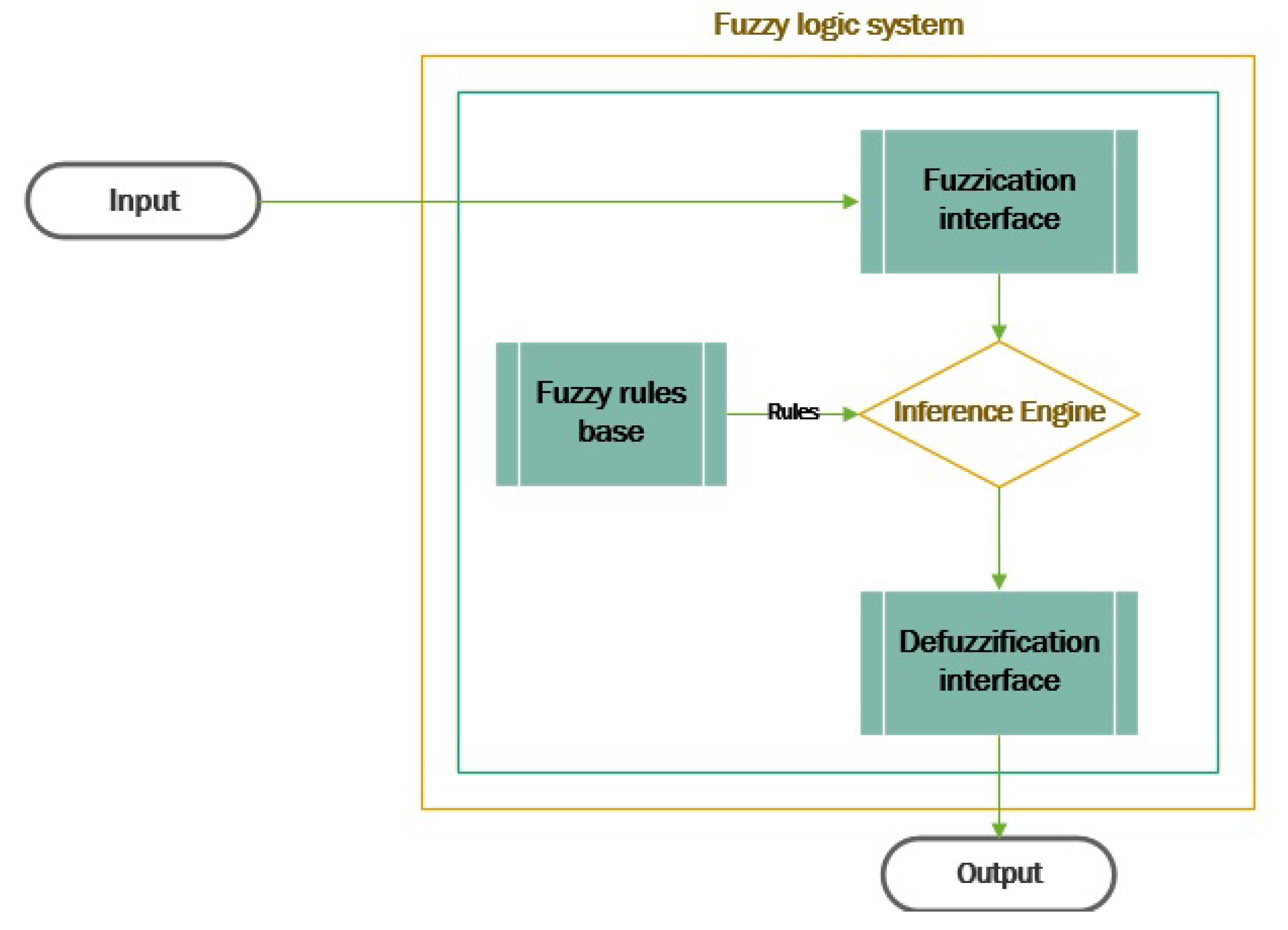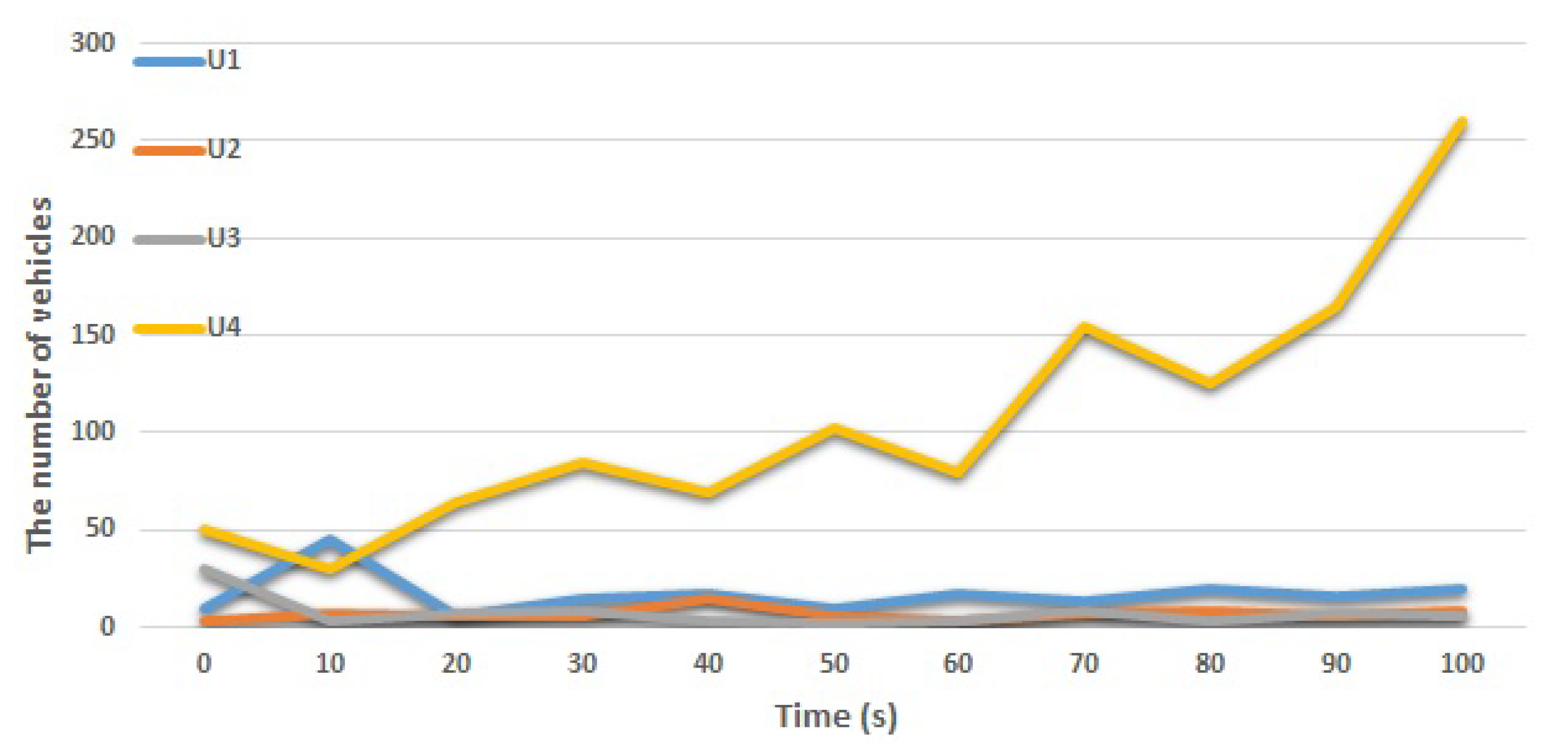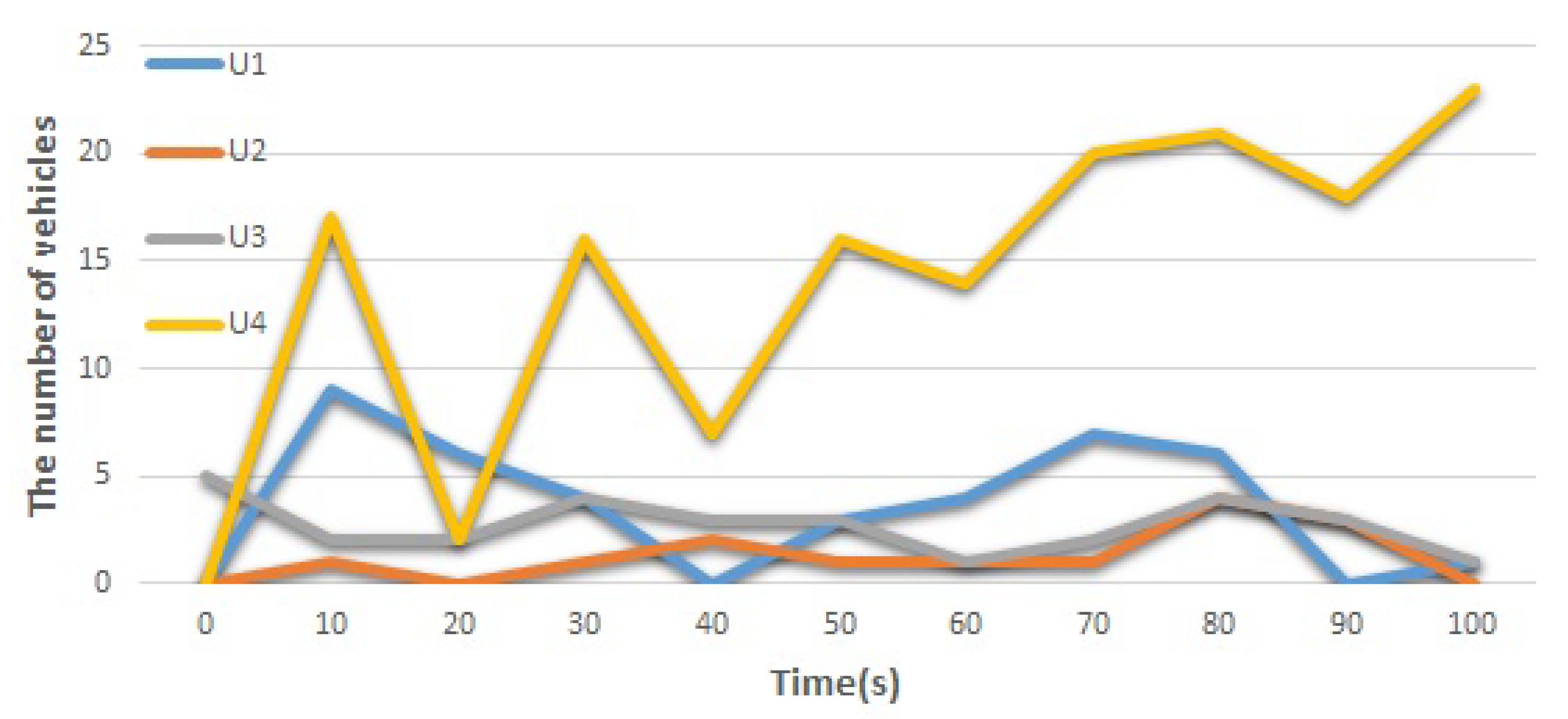Traffic Control Prediction Design Based on Fuzzy Logic and Lyapunov Approaches to Improve the Performance of Road Intersection
Abstract
:1. Introduction
- A comprehensive model of vehicle behavior for the city’s transportation system at intersections on two levels is provided.
- We tested and imitated the given intersection model in traffic conditions.
- We show that the fuzzy controller design reduced the number of vehicles waiting in line and the time required to wait at red lights.
- Evaluation of the average number of cars in a row in two ways, one without a controller and one with a controller over a certain duration.
2. Literature Review
2.1. Overview Control Traffic
2.2. Fuzzy Controller-Based Traffic Control
3. State-Space Difference of the Single Intersection
4. The Proposed Framework
Fuzzy Logic-Systems
- Flexible implementation; computational seriousness of machine learning methods.
- Ability to simulate human logic and thinking.
- Ability to create two solutions or answers to a problem.
- A good solution to a problem with an expected answer.
- A practical approach that uses flexible states in logic for reasoning.
- Ability to generate nonlinear functions using random complex numbers.
- Strong dependence on the researcher in creating fuzzy logic models.
5. Designing Stable TS Fuzzy Controller for Single Intersection
6. Mathematical Model of the Controlled System
7. Simulation Results
7.1. Fixed-Time Control
7.2. Fuzzy Intelligent Controller
8. Conclusions
9. Discussion and Future Direction
- The logic of fuzzy is close to human reasoning.
- Fuzzy logic programs are fast and inexpensive.
- It can be easily designed.
- It is widely used in decisive control and forecasting systems.
- Experts determine the principles of logic in fuzzy.
- Analyzing a system using fuzzy logic is not easy, as the reaction is unpredictable.
- Features can be time-consuming and incorrectly fixed.
- Fuzzy membership function parameters can be selected optimally with methods.
- The functions of the memberships used triangular, which can be derived from other membership functions, such as Gauss, etc.
- Investigate classical control techniques such as optimal control, adaptive control, robust control, etc., to design a coordinated traffic signal control system for several adjacent intersections.
Author Contributions
Data Availability Statement
Acknowledgments
Conflicts of Interest
References
- Zhang, L.; Zhao, Q.; Wang, L.; Zhang, L. Urban intersection signal control based on time-space resource scheduling. IEEE Access 2021, 9, 49281–49291. [Google Scholar] [CrossRef]
- Shahbazi, Z.; Byun, Y.C. A framework of vehicular security and demand service prediction based on data analysis integrated with blockchain approach. Sensors 2021, 21, 3314. [Google Scholar] [CrossRef]
- Shahbazi, Z.; Byun, Y.C. A Procedure for Tracing Supply Chains for Perishable Food Based on Blockchain, Machine Learning and Fuzzy Logic. Electronics 2021, 10, 41. [Google Scholar] [CrossRef]
- Shahbazi, Z.; Byun, Y.C. Integration of Blockchain, IoT and Machine Learning for Multistage Quality Control and Enhancing Security in Smart Manufacturing. Sensors 2021, 21, 1467. [Google Scholar] [CrossRef] [PubMed]
- Shahbazi, Z.; Byun, Y.C. Smart Manufacturing Real-Time Analysis Based on Blockchain and Machine Learning Approaches. Appl. Sci. 2021, 11, 3535. [Google Scholar] [CrossRef]
- Shahbazi, Z.; Byun, Y.C. Blockchain and Machine Learning for Intelligent Multiple Factor-Based Ride-Hailing Services. CMC-Comput. Mater. Contin. 2022, 70, 4429–4446. [Google Scholar] [CrossRef]
- Jiang, T.; Wang, Z.; Chen, F. Urban Traffic Signals Timing at Four-Phase Signalized Intersection Based on Optimized Two-Stage Fuzzy Control Scheme. Math. Probl. Eng. 2021, 2021. [Google Scholar] [CrossRef]
- Zadeh, L.A. Outline of a new approach to the analysis of complex systems and decision processes. IEEE Trans. Syst. Man Cybern. 1973, 28–44. [Google Scholar] [CrossRef] [Green Version]
- Chatterjee, K.; De, A.; Chan, F.T. Real time traffic delay optimization using shadowed type-2 fuzzy rule base. Appl. Soft Comput. 2019, 74, 226–241. [Google Scholar] [CrossRef]
- Pappis, C.P.; Mamdani, E.H. A fuzzy logic controller for a trafc junction. IEEE Trans. Syst. Man Cybern. 1977, 7, 707–717. [Google Scholar] [CrossRef]
- Vogel, A.; Oremović, I.; Šimić, R.; Ivanjko, E. Improving traffic light control by means of fuzzy logic. In Proceedings of the 2018 International Symposium ELMAR, Zadar, Croatia, 16–19 September 2018; pp. 51–56. [Google Scholar]
- Tunc, I.; Yesilyurt, A.Y.; Soylemez, M.T. Different Fuzzy Logic Control Strategies for Traffic Signal Timing Control with State Inputs. IFAC-PapersOnLine 2021, 54, 265–270. [Google Scholar] [CrossRef]
- Geronimo, M.F.; Martinez, E.G.H.; Vazquez, E.D.F.; Godoy, J.J.F.; Anaya, G.F. A multiagent systems with Petri Net approach for simulation of urban traffic networks. Comput. Environ. Urban Syst. 2021, 89, 101662. [Google Scholar] [CrossRef]
- Wu, C.Y.; Hu, M.B.; Jiang, R.; Hao, Q.Y. Effects of road network structure on the performance of urban traffic systems. Phys. A Stat. Mech. Its Appl. 2021, 563, 125361. [Google Scholar] [CrossRef]
- Sirmatel, I.I.; Geroliminis, N. Stabilization of city-scale road traffic networks via macroscopic fundamental diagram-based model predictive perimeter control. Control Eng. Pract. 2021, 109, 104750. [Google Scholar] [CrossRef]
- Jamil, F.; Kim, D. Payment mechanism for electronic charging using blockchain in smart vehicle. Korea 2019, 30, 31. [Google Scholar]
- Ahmad, S.; Jamil, F.; Khudoyberdiev, A.; Kim, D. Accident risk prediction and avoidance in intelligent semi-autonomous vehicles based on road safety data and driver biological behaviours. J. Intell. Fuzzy Syst. 2020, 38, 4591–4601. [Google Scholar] [CrossRef]
- Ahmad, S.; Jamil, F.; Iqbal, N.; Kim, D. Optimal route recommendation for waste carrier vehicles for efficient waste collection: A step forward towards sustainable cities. IEEE Access 2020, 8, 77875–77887. [Google Scholar] [CrossRef]
- Wang, H.; Hu, P.; Wang, H. A genetic timing scheduling model for urban traffic signal control. Inf. Sci. 2021, 576, 475–483. [Google Scholar] [CrossRef]
- Jovanović, A.; Kukić, K.; Stevanović, A. A fuzzy logic simulation model for controlling an oversaturated diverge diamond interchange and ramp metering system. Math. Comput. Simul. 2021, 182, 165–181. [Google Scholar] [CrossRef]
- Kartikasari, R.Y.; Prakarsa, G.; Pradeka, D. Optimization of Traffic Light Control Using Fuzzy Logic Sugeno Method. Int. J. Glob. Oper. Res. 2020, 1, 51–61. [Google Scholar] [CrossRef]
- Zhou, C.; Mo, H.; Chen, X.; Wen, H. Fuzzy Control Under Time-Varying Universe and Phase Optimization in Traffic Lights (ICSSE 2020). Int. J. Fuzzy Syst. 2021, 23, 692–703. [Google Scholar] [CrossRef]
- Yi-Fei, W.; Zheng, G. Research on polling based traffic signal control strategy with fuzzy control. In Proceedings of the 2018 IEEE 4th International Conference on Computer and Communications (ICCC), Chengdu, China, 7–10 December 2018; pp. 500–504. [Google Scholar]
- Karimzadeh, M.; Schwegler, S.M.; Zhao, Z.; Braun, T.; Sargento, S. MTL-LSTM: Multi-Task Learning-based LSTM for Urban Traffic Flow Forecasting. In Proceedings of the 2021 International Wireless Communications and Mobile Computing (IWCMC), Harbin, China, 28 June–2 July 2021; pp. 564–569. [Google Scholar]
- Vázquez, J.J.; Arjona, J.; Linares, M.; Casanovas-Garcia, J. A comparison of deep learning methods for urban traffic forecasting using floating car data. Transp. Res. Procedia 2020, 47, 195–202. [Google Scholar] [CrossRef]
- Chu, T.; Wang, J.; Codecà, L.; Li, Z. Multi-agent deep reinforcement learning for large-scale traffic signal control. IEEE Trans. Intell. Transp. Syst. 2019, 21, 1086–1095. [Google Scholar] [CrossRef] [Green Version]
- Neelakandan, S.; Berlin, M.; Tripathi, S.; Devi, V.B.; Bhardwaj, I.; Arulkumar, N. IoT-based traffic prediction and traffic signal control system for smart city. Soft Comput. 2021, 25, 12241–12248. [Google Scholar] [CrossRef]
- Tsai, C.W.; Teng, T.C.; Liao, J.T.; Chiang, M.C. An effective hybrid-heuristic algorithm for urban traffic light scheduling. Neural Comput. Appl. 2021, 33, 17535–17549. [Google Scholar] [CrossRef]
- Joo, H.; Ahmed, S.H.; Lim, Y. Traffic signal control for smart cities using reinforcement learning. Comput. Commun. 2020, 154, 324–330. [Google Scholar] [CrossRef]
- Rahman, R.; Hasan, S. Real-time signal queue length prediction using long short-term memory neural network. Neural Comput. Appl. 2021, 33, 3311–3324. [Google Scholar] [CrossRef]
- Wang, J.; Lv, W.; Jiang, Y.; Qin, S.; Li, J. A multi-agent based cellular automata model for intersection traffic control simulation. Phys. A Stat. Mech. Its Appl. 2021, 584, 126356. [Google Scholar] [CrossRef]
- Zhao, H.; Han, G.; Niu, X. The signal control optimization of road intersections with slow traffic based on improved PSO. Mob. Netw. Appl. 2020, 25, 623–631. [Google Scholar] [CrossRef]
- Mao, T.; Mihăită, A.S.; Chen, F.; Vu, H.L. Boosted Genetic Algorithm using Machine Learning for traffic control optimization. IEEE Trans. Intell. Transp. Syst. 2021. [Google Scholar] [CrossRef]
- Khelafa, I.; Ballouk, A.; Baghdad, A. Control algorithm for the urban traffic using a realtime simulation. Int. J. Electr. Comput. Eng. 2021, 11, 3934–3942. [Google Scholar] [CrossRef]
- Mou, J. Intersection traffic control based on multi-objective optimization. IEEE Access 2020, 8, 61615–61620. [Google Scholar] [CrossRef]
- Ali, M.; Devi, G.L.; Neelapu, R. Intelligent Traffic Signal Control System Using Machine Learning Techniques. In Microelectronics, Electromagnetics and Telecommunications; Springer: Berlin, Germany, 2021; pp. 611–619. [Google Scholar]
- Azimirad, E.; Pariz, N.; Sistani, M.B.N. A novel fuzzy model and control of single intersection at urban traffic network. IEEE Syst. J. 2010, 4, 107–111. [Google Scholar] [CrossRef]
- Park, I.S.; Park, C.e.; Kwon, N.K.; Park, P. Dynamic output-feedback control for singular interval-valued fuzzy systems: Linear matrix inequality approach. Inf. Sci. 2021, 576, 393–406. [Google Scholar] [CrossRef]
- Bernal, E.; Lagunes, M.L.; Castillo, O.; Soria, J.; Valdez, F. Optimization of type-2 fuzzy logic controller design using the GSO and FA algorithms. Int. J. Fuzzy Syst. 2021, 23, 42–57. [Google Scholar] [CrossRef]
- Kim, S.S.; Chung, M.; Kim, Y.K. Urban traffic prediction using congestion diffusion model. In Proceedings of the 2020 IEEE International Conference on Consumer Electronics-Asia (ICCE-Asia), Seoul, Korea, 1–3 November 2020; pp. 1–4. [Google Scholar]
- Tang, J.; Zeng, J.; Wang, Y.; Yuan, H.; Liu, F.; Huang, H. Traffic flow prediction on urban road network based on License Plate Recognition data: Combining attention-LSTM with Genetic Algorithm. Transp. A Transp. Sci. 2021, 17, 1217–1243. [Google Scholar] [CrossRef]
- Li, D.; Deng, L.; Cai, Z. Intelligent vehicle network system and smart city management based on genetic algorithms and image perception. Mech. Syst. Signal Process. 2020, 141, 106623. [Google Scholar] [CrossRef]
- Bethge, J.; Morabito, B.; Rewald, H.; Ahsan, A.; Sorgatz, S.; Findeisen, R. Modelling Human Driving Behavior for Constrained Model Predictive Control in Mixed Traffic at Intersections. IFAC-PapersOnLine 2020, 53, 14356–14362. [Google Scholar] [CrossRef]
- Jafari, S.; Shahbazi, Z.; Byun, Y.C. Improving the Performance of Single-Intersection Urban Traffic Networks Based on a Model Predictive Controller. Sustainability 2021, 13, 5630. [Google Scholar] [CrossRef]





| Author | Model | Objective | Limit |
|---|---|---|---|
| Mostafa et al. [24] | Multitask learning long short term memory | Predict traffic flow | Urban traffic flow |
| Juan et al. [25] | Deep learning | Forecasting urban traffic | Urban traffic |
| Tianshu et al. [26] | Multiagent deep reinforcement learning | Stabilize the learning procedure | Large-Scale traffic signal |
| S. Neelakandan et al. [27] | IoT-based traffic prediction | Optimization | Smart city |
| Chun-Wei et al. [28] | Effective hybrid-heuristic algorithm | Optimization speed of the search algorithm | Urban traffic light |
| Hyunjin et al. [29] | Reinforcement learning | Handle large and complex data | Traffic signal control |
| Rezaur et al. [30] | Long short-term memory neural network | Real-time signal queue length prediction | Urban traffic |
| Mingtao et al. [31] | Multiagent | Optimization | Urban traffic signal |
| Hongluan et al. [32] | PSO | Optimization | Road intersections |
| Tuo et al. [33] | Boosted genetic algorithm | Optimization | Traffic control |
| Ilyas et al. [34] | Reduce congestion and improve the safety | Reduce congestion and improve | Urban traffic |
| Jinbao et al. [35] | Multiobjective | Optimization | Intersection traffic |
| Mohammad et al. [36] | Machine learning techniques | Optimization | Traffic signal control |
| Component | Description |
|---|---|
| Queue length | |
| The number of vehicles entering the queue | |
| The number of vehicles leaving the queue | |
| Control signal | |
| Waiting time | |
| T | Sampling time |
| The vector of variables of mode | |
| Control signal | |
| Identity matrix | |
| Metrics | |
| Traffic condition | |
| P | Positive definite |
| Input | Fuzzy Rules |
|---|---|
| A sample of rules of Z1 | If (U1(n) + U3(n) is H,(U2(n) + U4(n) is H), (d1 + d3 is H) and (q1 + q3 is L), then (Z1 is 0) |
| A sample of rules of Z2 | If (U1(n) + U3(n) is M, (U2(n) + U4(n) is M), (d2 + d4 is H) and (q2 + q4 is L), then (Z2 is 0) |
| Traffic Condition | |
|---|---|
| Nonimpregnation | ≥ 0.7 |
| Impregnation | 0.4 ≤ ≤ 0.6 |
| Super-impregnation | 0.1 ≤ ≤ 0.3 |
| Unstable | 0 = |
| Queue Length | Fixed-Time Control | Fuzzy Intelligent Control | Total Improvement Percentage |
|---|---|---|---|
| U1 | 45 | 9 | 80.00 |
| U2 | 15 | 4 | 73.33 |
| U3 | 30 | 5 | 83.33 |
| U4 | 260 | 23 | 91.15 |
| SUM | 350 | 41 | 88.29 |
| Author | Model | Problem | Solution | Advantage |
|---|---|---|---|---|
| Sung-Soo et al. [40] | Congestion diffusion | Urban traffic | Prediction | Reducing traffic congestion and improving transportation |
| Jinjun et al. [41] | Combining LSTM with genetic algorithm | Traffic flow | Predictive | Optimize |
| Daming et al. [42] | Genetic algorithms and image perception | Urban traffic | Improve the efficiency | Management systems and alleviating urban traffic congestion |
| Johanna et al. [43] | Model predictive control | Traffic at intersections | Predictive | Optimization |
| Jafari et al. [44] | MPC | Urban Traffic | Reducing the queue length of vehicle | Optimization Prediction |
| Proposed model | Fuzzy intelligent controller | Urban traffic | Reduce the length of queue and average waiting time | Optimization Prediction |
Publisher’s Note: MDPI stays neutral with regard to jurisdictional claims in published maps and institutional affiliations. |
© 2021 by the authors. Licensee MDPI, Basel, Switzerland. This article is an open access article distributed under the terms and conditions of the Creative Commons Attribution (CC BY) license (https://creativecommons.org/licenses/by/4.0/).
Share and Cite
Jafari, S.; Shahbazi, Z.; Byun, Y.-C. Traffic Control Prediction Design Based on Fuzzy Logic and Lyapunov Approaches to Improve the Performance of Road Intersection. Processes 2021, 9, 2205. https://doi.org/10.3390/pr9122205
Jafari S, Shahbazi Z, Byun Y-C. Traffic Control Prediction Design Based on Fuzzy Logic and Lyapunov Approaches to Improve the Performance of Road Intersection. Processes. 2021; 9(12):2205. https://doi.org/10.3390/pr9122205
Chicago/Turabian StyleJafari, Sadiqa, Zeinab Shahbazi, and Yung-Cheol Byun. 2021. "Traffic Control Prediction Design Based on Fuzzy Logic and Lyapunov Approaches to Improve the Performance of Road Intersection" Processes 9, no. 12: 2205. https://doi.org/10.3390/pr9122205
APA StyleJafari, S., Shahbazi, Z., & Byun, Y.-C. (2021). Traffic Control Prediction Design Based on Fuzzy Logic and Lyapunov Approaches to Improve the Performance of Road Intersection. Processes, 9(12), 2205. https://doi.org/10.3390/pr9122205








